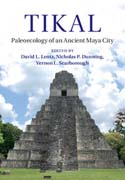
Tikal: Paleoecology of an Ancient Maya City
Lentz, David L.
Dunning, Nicholas P.
Scarborough, Vernon L.
The primary theoretical question addressed in this book focuses on the lingering concern of how the ancient Maya in the northern Petén Basin were able to sustain large populations in the midst of a tropical forest environment during the Late Classic period. This book asks how agricultural intensification was achieved and how essential resources, such as water and forest products, were managed in both upland areas and seasonal wetlands, or bajos. All of these activities were essential components of an initially sustainable land use strategy that eventually failed to meet the demands of an escalating population. This spiraling disconnect with sound ecological principles undoubtedly contributed to the Maya collapse. The book's findings provide insights that broaden the understanding of the rise of social complexity - the expansion of the political economy, specifically - and, in general terms, the trajectory of cultural evolution of the ancient Maya civilization. INDICE: 1. Tikal land, water, and forest: an introduction Nicholas P. Dunning, David L. Lentz and Vernon L. Scarborough; 2. The evolution of an ancient waterworks system at Tikal Vernon L. Scarborough and Liwy Grazioso Sierra; 3. At the core of Tikal: terrestrial sediment sampling and water management Brian Lane, Vernon L. Scarborough and Nicholas P. Dunning; 4. Bringing the University of Pennsylvania maps of Tikal into the era of electronic GIS Christopher Carr, Eric Weaver, Nicholas P. Dunning and Vernon L. Scarborough; 5. Examining landscape modifications for water management at Tikal using three-dimensional modeling with Arcgis .91 Eric Weaver, Christopher Carr, Nicholas P. Dunning, Lee Florea and Vernon L. Scarborough; 6. Life on the edge: Tikal in a bajo landscape Nicholas P. Dunning, Robert E. Griffin, John G. Jones, Richard E. Terry, Zachary Larsen and Christopher Carr; 7. Connecting contemporary ecology and ethnobotany to ancient plant use practices of the Maya at Tikal Kim Thompson, Angela Hood, Dana Cavallaro and David L. Lentz; 8. Agroforestry and agricultural practices of the ancient Maya at Tikal David L. Lentz, Kevin Magee, Eric Weaver, John G. Jones, Kenneth B. Tankersley, Angela Hood, Gerald Islebe, Carmen Ramos and Nicholas P. Dunning; 9. Fire and water: the archaeological significance of Tikal's Quaternary sediments Kenneth Tankersley, Nicholas P. Dunning, Vernon L. Scarborough, John Jones, Christopher Carr and David L. Lentz; 10. Fractious farmers at Tikal David Webster and Timothy Murtha; 11. The material culture of Tikal Palma Buttles, Carmen Ramos and Fred Valdez, Jr; 12. A neighborly view: water and environmental history of the El Zotz region Timothy Beach, Sheryl Luzzadder-Beach, Jonathan Flood, Stephen Houston, Thomas Garrison, Edwin Román, Steve Bozarth and James Doyle; 13. Defining the constructed niche of Tikal: a summary view David L. Lentz, Nicholas P. Dunnin and Vernon L. Scarborough.
- ISBN: 978-1-107-02793-0
- Editorial: Cambridge University Press
- Encuadernacion: Cartoné
- Páginas: 374
- Fecha Publicación: 23/02/2015
- Nº Volúmenes: 1
- Idioma: Inglés
